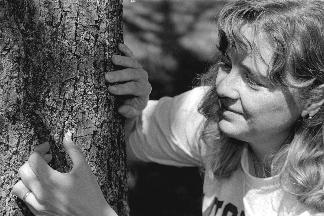The University Record, September 10, 1997
|
|
Jane Immonen, forestry assistant in Grounds and Waste Management, examines a tree for signs of gypsy moth infestation. Photo by Bob Kalmbach |
Editor’s Note: In recent months, many members of the University community have called Grounds and Waste Management and the School of Natural Resources and Environment (SNRE) to inquire about the gypsy moth infestation and its affect on campus. To address those inquiries, the following Q & A was prepared by Marvin Pettway, arborist, Grounds and Waste Management, with help from Doug Fasing, manager, Grounds and Waste Management; Harrison Morton, SNRE associate dean; and Paul Bairly, forestry technician, Forestry Division, City of Ann Arbor Parks and Recreation Department.
What happened with the gypsy moths on campus in 1997?
On North Campus, particularly the woods around the School of Music, the gypsy moth larvae were very abundant and eating everything in sight. The oaks and the serviceberry tress at Pierpont Commons also were heavily infested. Other sections of North Campus were less affected. On the Central, South and Medical campuses, there was very little defoliation, although some gypsy moth larvae were sighted.
What did the University or the City of Ann Arbor do to manage the gypsy moth larvae?
Several areas of campus were sprayed with Bacillus thuringiensis (Bt), the safest and most commonly used material. The Diag was treated once and Bt seemed to work quite effectively. We made three applications of Bt on North Campus, yet the larvae continued to defoliate the trees at Pierpont Commons.
The University and the City of Ann Arbor have been trapping male gypsy moths to monitor population density since 1995. The monitoring plan placed four traps on North Campus and three traps on Central and South Campus areas. The are located at Plymouth and Bishiop; Pierpont Commons, near the Family Housing Community Center; at the North Campus compost site; West Hall (Engineering) Arch, Inglis House and the “Blue” Golf Course.
The data received from monitoring led to the decision not to treat for gypsy moth in either spring 1996 or spring 1997. The population densities did not show evidence that warranted an aerial treatment, although aerial spraying remains an option for gypsy moth control in the future.
Did the cool, wet spring affect the gypsy moth population?
We do not believe that the weather affected the larvae. It may, however, have altered the effectiveness of the Bt treatments in certain areas, for example, Pierpont Commons. What may have happened is that the tree leaves were slowed in their development by the cool weather in April, but the larva developed at their normal rate in May. Therefore, by the time we made our treatments, the larvae had developed to a stage where they were less vulnerable to a Bt treatment.
Will the defoliation kill all the trees in the School of Music woods?
Healthy deciduous trees can tolerate two or three consecutive years of defoliation; however, this is very stressful to the trees. As of this writing, the trees have grown new leaves.
What will the University do now and next year?
We are continuing to work with the city to monitor gypsy moth densities and geographic data has been gathered on the degree of tree defoliation. The University, the city and Washtenaw County will use this data in coordinating a countywide treatment effort that will include University property.
What can homeowners or the owners of small woodlots do to help their trees recover from this year’s defoliation and to protect against future gypsy moth infestation?
A simple list of measures a homeowner could take to help landscape trees includes watering, fertilizing and placing a physical barrier of burlap around susceptible trees to reduce the number of gypsy moth larvae.
An excellent source of information is the extension bulletin produced by Michigan State University and the Michigan Department of Agriculture, Gypsy Moth in Michigan: Homeowner’s Guide (Extension Bulletin E-2302). It gives detailed instructions on monitoring and managing gypsy moth, has excellent color photos of the various stages of the gypsy moth life cycle and lists the trees and shrubs that are at risk of defoliation by gypsy moth. The bulletin also cautions against expecting quick fixes for the gypsy moth problem. It is available at county extension offices, including the office located in the Washtenaw County Service Center, 4133 Washtenaw Ave.
Information also is available on the Web at: http://www.co.washtenaw.mi.us/GYPSY.HTM.


